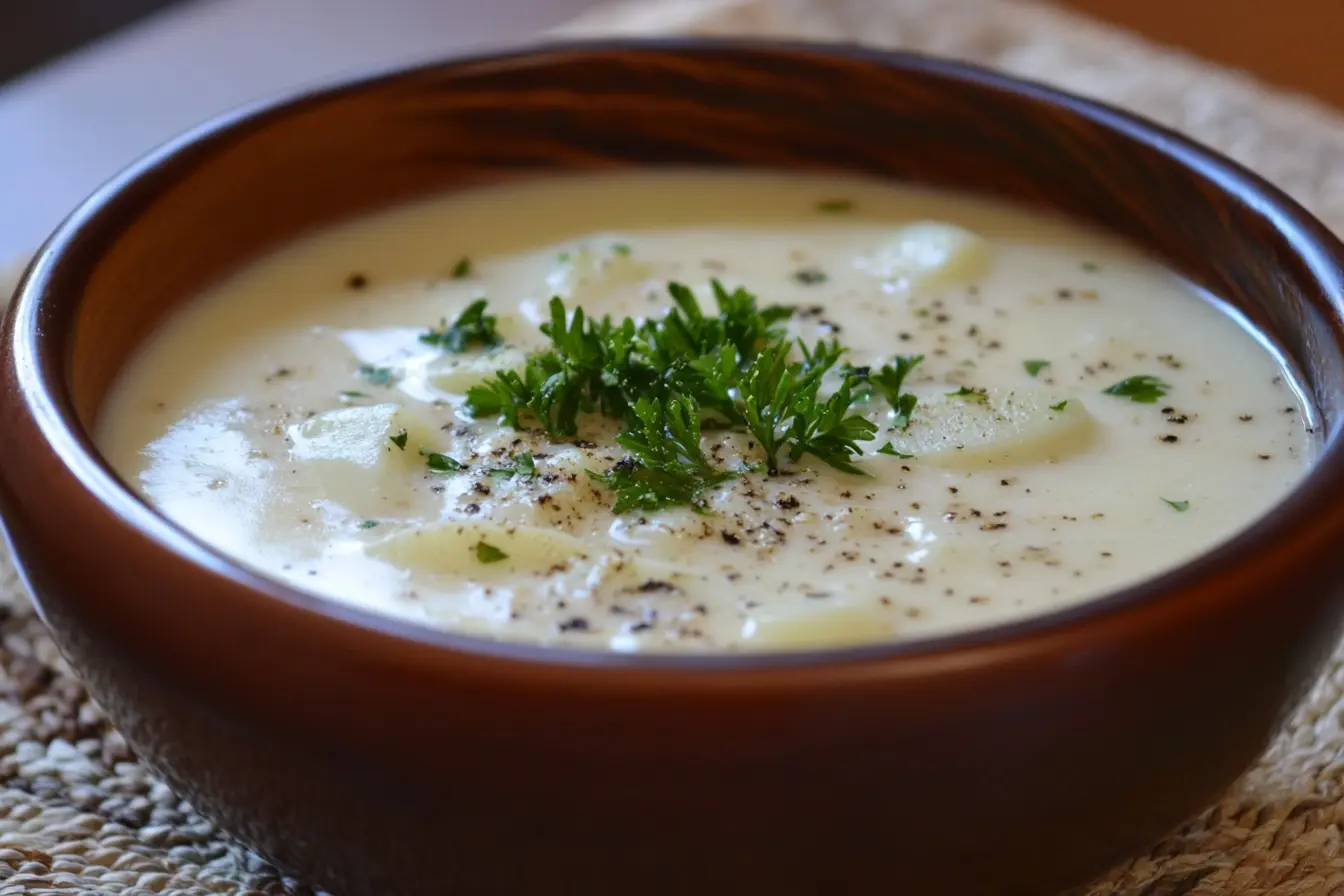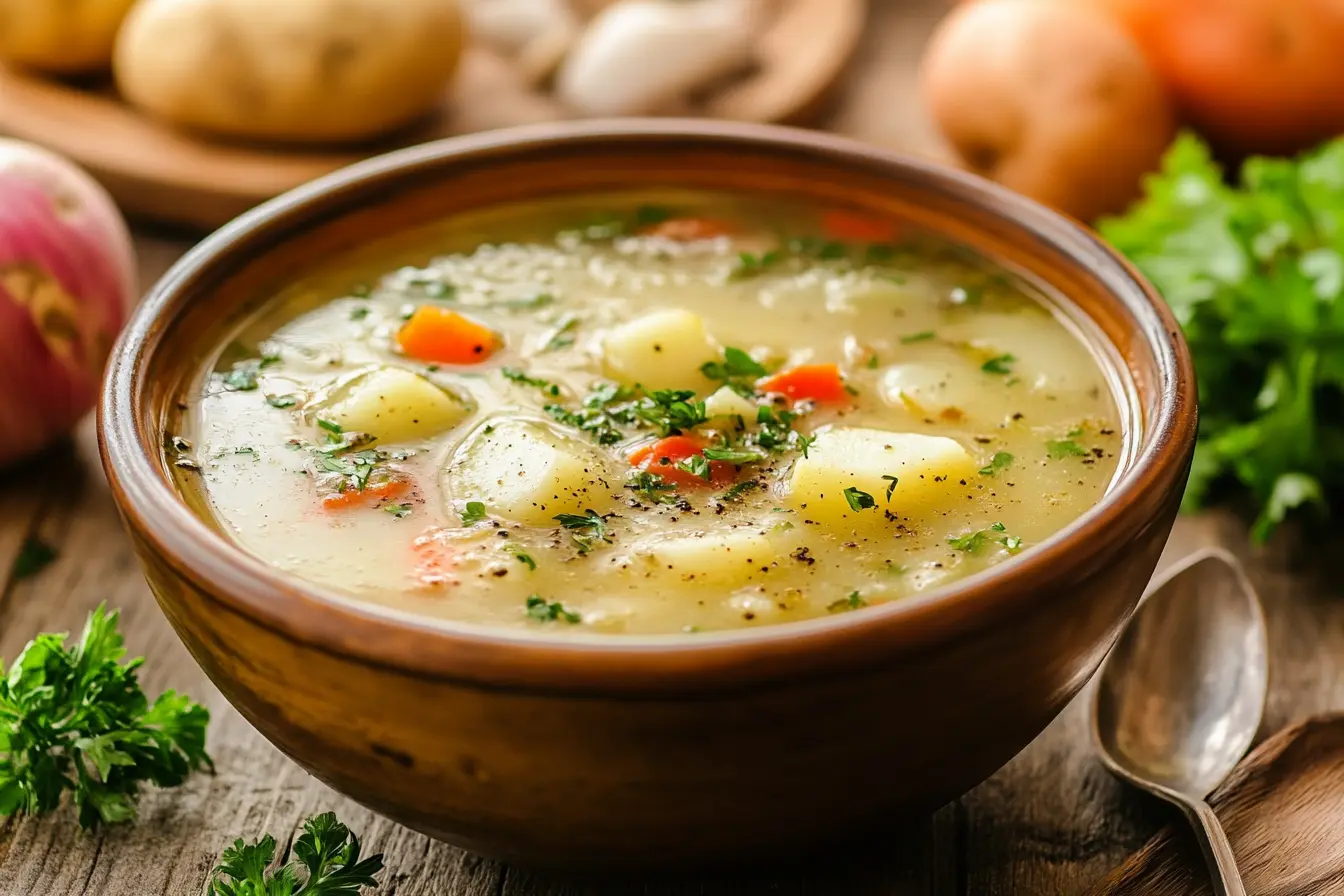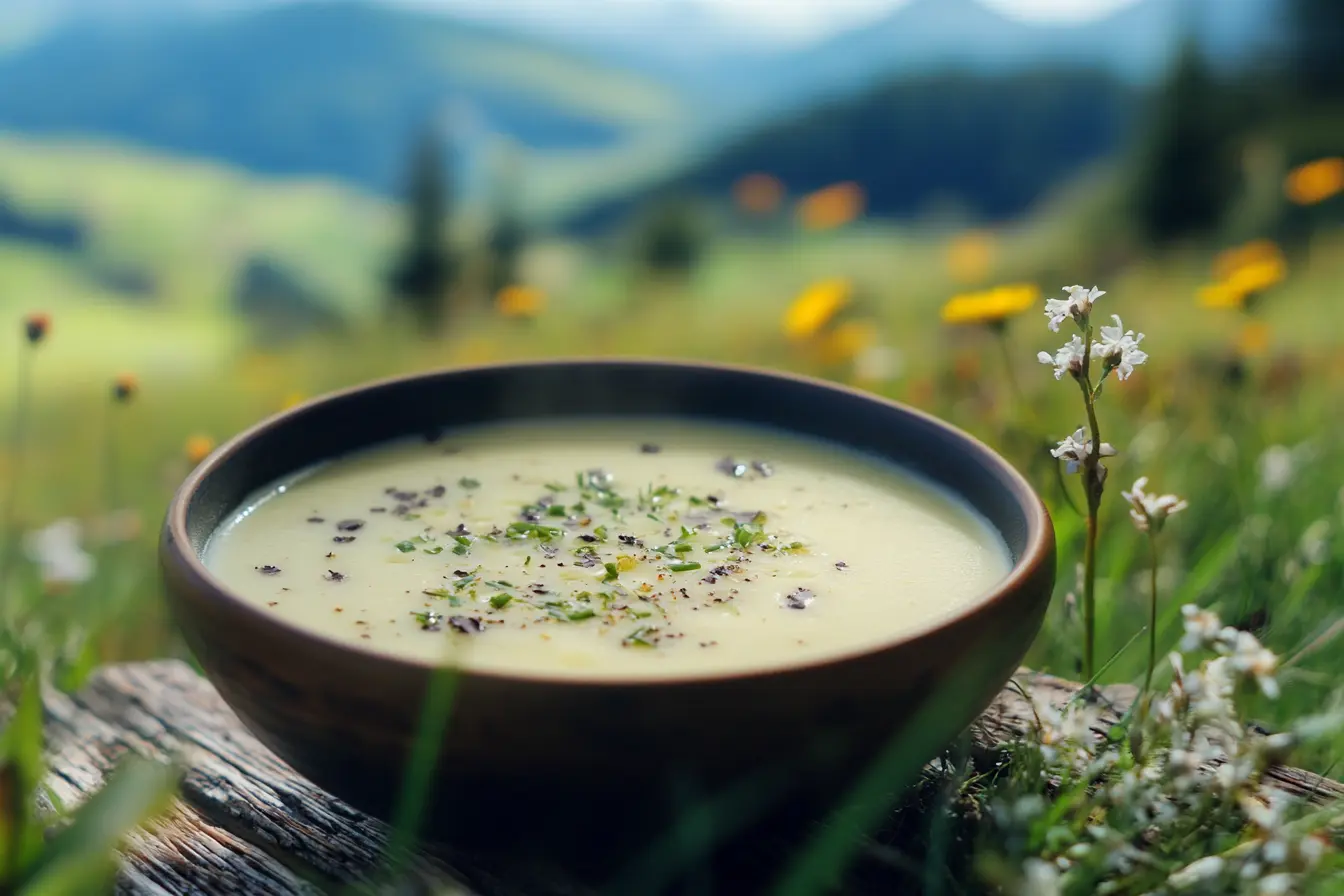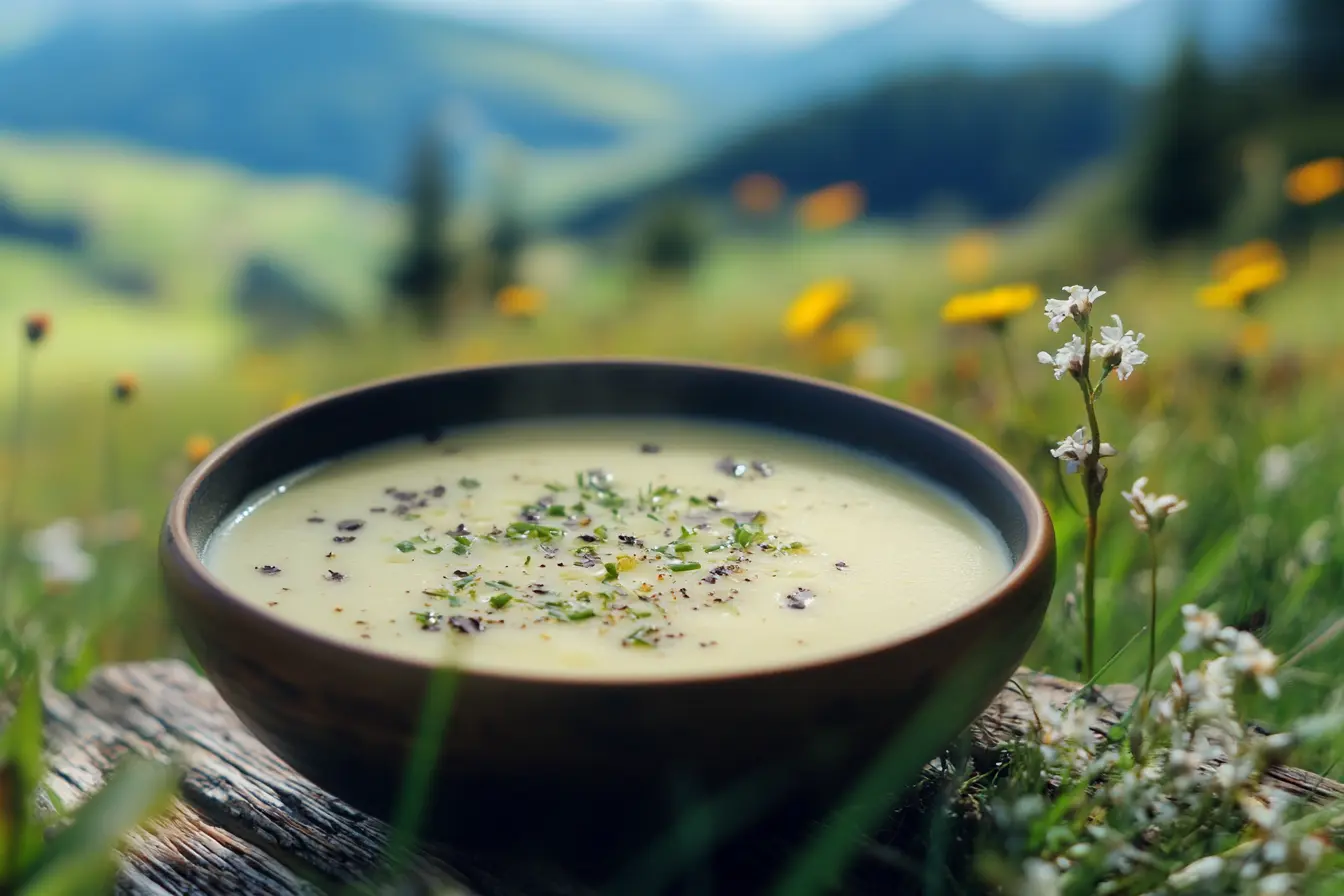 Have you ever made a delicious pot of potato soup, only to find it’s too watery? Instead of the thick, creamy soup you wanted, it’s thin and watery. Don’t worry, there are ways to fix it and make it great again.
Have you ever made a delicious pot of potato soup, only to find it’s too watery? Instead of the thick, creamy soup you wanted, it’s thin and watery. Don’t worry, there are ways to fix it and make it great again.
Key Takeaways
- Identify the cause of the watery consistency, such as not enough starch or too much liquid
- Use thickening agents like roux or cornstarch slurry to quickly thicken the soup
- Adjust the seasoning to enhance the flavor and balance the thickened texture
- Prevent watery potato soup in the future by using the proper potato to liquid ratio and cooking techniques
- Salvage an overly watery soup or find creative uses for the thinner consistency
Identifying the Cause of Watery Potato Soup
Watery potato soup often comes from two main issues: the potatoes’ starch content and the recipe’s liquid amount. Knowing these causes is key to making the soup creamy and perfect.
Not Enough Starch
Potatoes naturally thicken soup because they’re full of starch. But if the potatoes lack enough starch, the soup will be too watery. This might happen if the potatoes aren’t the right type or if they’re overcooked, breaking down the starch.
Check out this guide on russet potato recipes to ensure you’re using the best type of potatoes for thickening.
Too Much Liquid
Adding too much liquid, like broth, milk, or water, also makes potato soup watery. If the potatoes and liquid aren’t balanced, the soup won’t get thick enough.
| Cause | Impact on Soup Texture |
|---|---|
| Not Enough Starch | Thin, watery consistency |
| Too Much Liquid | Excessively thin, diluted soup |
Figuring out why your potato soup is watery helps you fix it. Whether it’s not enough starch or too much liquid, you can adjust to make it creamy and delicious again.
What to do if my potato soup is too watery?
If your potato soup is too watery, don’t worry. There are steps to thicken it and get the perfect consistency. Here’s how to fix watery potato soup:
- Identify the cause – Find out why your soup is watery. It could be not enough starch or too much liquid.
- Adjust the starch – Add more mashed potatoes, potato flakes, or a roux if your soup lacks starch.
- Reduce the liquid – If there’s too much broth or water, simmer the soup uncovered to evaporate some liquid.
- Use a thickening agent – Adding a cornstarch slurry or flour can help bind the soup and make it creamier.
- Season to taste – After adjusting the consistency, check the seasoning. Add salt, pepper, or herbs as needed.
By following these steps, you can turn a watery potato soup into a thick and creamy dish. The key is to find the cause and adjust accordingly for the perfect texture.
| Step | Action | Benefit |
|---|---|---|
| 1 | Identify the cause of the watery soup | Determines the appropriate solution |
| 2 | Add more starch (mashed potatoes, potato flakes, or roux) | Thickens the soup |
| 3 | Reduce the liquid by simmering uncovered | Removes excess liquid |
| 4 | Use a thickening agent (cornstarch slurry or flour) | Binds the soup for a creamier texture |
| 5 | Adjust the seasoning | Enhances the overall flavor |
For more details on these steps, visit this potato soup recipe guide.
Follow these steps to turn a watery potato soup into a thick and creamy dish. Remember, the key is to identify the cause and adjust accordingly for the perfect texture.
“The secret to a perfect potato soup lies in mastering the balance between starch and liquid.”
With some experimentation and these techniques, you can fix watery potato soup. Serve a hearty, satisfying dish that everyone will love.
Thickening Agents for Watery Potato Soup
When your potato soup is too thin, you can use roux or cornstarch slurry to fix it. These methods make the soup rich and velvety, making it more satisfying.
Roux
Making a roux is a classic way to thicken potato soup. It’s a mix of fat (like butter or oil) and flour cooked together. This mixture thickens when added to liquid.
To make a roux, melt butter in a saucepan over medium heat. Whisk in an equal amount of flour and cook for 2-3 minutes, stirring constantly. The mixture should smell nutty.
Slowly whisk this roux into your potato soup. Let it simmer until it’s the right consistency.
Learn more about how a roux works with this guide on how to thicken soup.
Cornstarch Slurry
A cornstarch slurry is another great option for thickening. Mix equal parts cornstarch and cold water until smooth. Then, slowly add the slurry to your simmering potato soup while stirring.
This will make the soup thick and velvety. The cornstarch works wonders, turning the watery broth into a creamy delight.
Choosing between a roux or a cornstarch slurry can fix a watery potato soup. With these simple steps, you can get the creamy consistency perfect for a chilly day.
Adjusting the Seasoning
When thickening a potato soup, think about how it changes the flavor. Adding things like roux or cornstarch slurry can make the soup taste flat. To keep your potato soup tasty and well-seasoned, follow these tips:
- Taste as you go. Check the soup often and adjust the seasoning. This keeps the flavors balanced as the texture changes.
- Start with less seasoning. Use a bit less seasoning at first. This lets you adjust the flavors later without overdoing it.
- Add more aromatics. Increase the flavor with more garlic, onions, or herbs. These can balance the thick texture of the soup.
- Taste and adjust. After thickening, taste the soup again and adjust the seasoning. You might need more salt, pepper, or a bit of lemon juice or vinegar.
Pay attention to the seasoning and adjust as you thicken the potato soup. This ensures a balanced and tasty final dish. The seasoning for potato soup and balancing flavors in thick potato soup are key to a satisfying meal.

Preventing Watery Potato Soup in the Future
Getting the right balance between potatoes and liquid is key to avoiding watery potato soup. The ideal ratio of potatoes to liquid is crucial for a creamy, thick soup. Also, the way you cook can greatly affect the soup’s texture.
Proper Potato to Liquid Ratio
To avoid a watery soup, use the correct potato to liquid ratio. Aim for 1 part potatoes to 2-3 parts liquid. This ensures the potatoes thicken the soup without making it too watery.
Cooking Techniques for Thick Potato Soup
- Roast or sauté the potatoes before adding them to the soup. This helps to release more starch, leading to a thicker consistency.
- Mash or puree a portion of the cooked potatoes to incorporate their natural starch into the soup.
- Simmer the soup gently for a longer period of time to allow the starches to fully develop and thicken the liquid.
- Use a potato masher or immersion blender to break down some of the potato pieces, creating a creamier texture.
By focusing on the ideal potato to liquid ratio and using the right cooking techniques, you can make sure your potato soup is creamy and thick every time.
Salvaging an Overly Watery Soup
If your potato soup is too watery, don’t worry. There are ways to fix it. You can thicken the soup without losing its flavor or texture. Let’s look at some methods to make that thin potato soup creamy and satisfying.
Roux to the Rescue
Making a roux is a great way to thicken a watery soup. A roux is a mix of flour and fat cooked together. Melt butter or oil in a pan, then add an equal amount of flour. Cook it until it turns light golden, stirring constantly.
Then, slowly add this roux to your soup. Let it simmer to thicken the broth. This method is reliable and keeps the soup’s flavor.
Cornstarch Slurry
For a quick fix, try a cornstarch slurry. Mix equal parts cornstarch and cold water in a bowl until smooth. Slowly add this to your simmering soup, stirring well, until it’s thick enough.
When adding thickening agents, do it slowly. Let the soup simmer for a few minutes to blend well. Taste and adjust as needed to save the soup’s flavor.

With these simple steps, you can turn thin potato soup into a rich, creamy dish. Choose between a roux or a cornstarch slurry. Be patient and adjust the amounts until you get the right consistency.
Creative Uses for Watery Potato Soup
If you’ve ended up with watery potato soup, don’t worry! There are many ways to use it creatively. You can reduce food waste or try new recipes. These ideas will help you use your watery potato soup well.
Repurpose as a Cooking Base
The watery potato soup is perfect as a base for other dishes. Use it as a liquid in making:
- Risotto
- Braised meats
- Vegetable stews
- Pot pies
Incorporate into Sauces and Gravies
The mild taste of the watery potato soup is great for sauces and gravies. Try it as a broth or stock substitute in making:
- Mushroom gravy
- Béchamel sauce
- Cheese sauce
- Peppery pan sauces
Blend into Cream Soups
If you need cream of potato soup, the watery version works well. Blend it with dairy like milk or cream. This makes a creamy base for:
- Cream of broccoli soup
- Cream of chicken soup
- Cream of mushroom soup
Being creative with your watery potato soup helps reduce waste and opens up new cooking possibilities. Try these ideas to use every drop and add flavor to your meals.
Conclusion
Dealing with watery potato soup is a common issue in the kitchen. It’s easy to fix with a few simple steps. First, figure out why the soup is too watery, like not enough starch or too much liquid.
Then, you can take steps to thicken it. This article has shown you how to make your potato soup creamy and tasty. It covered using thickening agents like roux or cornstarch slurry, adjusting seasonings, and cooking methods.
Remember, the main tips for thickening potato soup are to keep the right potato to liquid ratio. Also, use proper cooking methods and have some thickening tricks ready. With these tips, you can easily fix watery potato soup and impress everyone with your cooking skills.
Now, you have the knowledge to handle any watery potato soup problem. Refine your recipes and make your potato soup always perfect. Enjoy the satisfaction of creating delicious meals for your loved ones.
FAQ
What to do if my potato soup is too watery?
If your potato soup is too watery, you can fix it with a few steps. Add more starch, reduce the liquid, and use thickening agents like roux or cornstarch slurry. For practical ways to fix watery soup, you can also check out Simple and Practical Ways to Thicken Soup from WikiHow.
What are the common causes of a watery potato soup?
Potato soup often becomes watery if not enough starch is used from the potatoes. Adding too much liquid is another common mistake. Knowing these causes helps you find the right fix. For more detailed guidance, visit MasterClass’s Comprehensive Guide on Soup Thickening.
How can I thicken my potato soup?
To thicken a watery potato soup, try different methods. Make a roux, create a cornstarch slurry, mash more potatoes, or simmer it longer. These steps help release starches and thicken the soup. You can also explore alternative thickening methods, such as those discussed in Simple and Practical Ways to Thicken Soup from WikiHow.
What are the best thickening agents for potato soup?
Roux and cornstarch slurry are top choices for thickening potato soup. Roux gives a rich, creamy texture. Cornstarch slurry adds a clear, glossy finish. Both work well to achieve the right thickness.
Do I need to adjust the seasoning when thickening potato soup?
Yes, adjust the seasoning when thickening potato soup. Adding thickening agents can change the flavor. Taste and adjust the seasoning to keep the soup balanced and tasty.
How can I prevent my potato soup from becoming in the future?
To avoid potato soup, focus on the right potato to liquid ratio and cooking techniques. Mash or blend some potatoes to release starch. Simmer the soup long enough for the starches to thicken the broth.
What can I do if I’ve already served an overly potato soup?
If your potato soup is already, you can still fix it. Add a roux or cornstarch slurry to the soup. Or blend in cooked potato pieces to thicken the broth. A few simple changes can rescue a thin soup.
How can I use up leftover watery potato soup?
Don’t waste watery potato soup. Get creative and use it in other dishes. Turn it into a cream of vegetable soup or mix it into potato pancakes or gnocchi.
